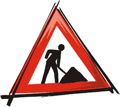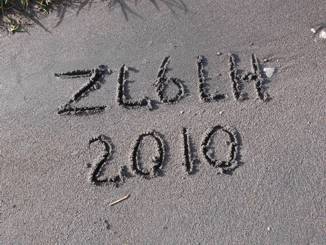ZL6LH 2010
International Lighthouse Lightship Weekend
Cape Egmont Lighthouse
International Lighthouse Lightship Weekend 2009
2009 ILLW activity was over the weekend 21st ~ 22nd August 2010.
ZL6LH team is John ZL1BYZ, John ZL1ALZ and David ZL1DK.
This year we operated from the Cape Egmont Lighthouse.

International Lighthouse & Lightship weekend 2010
ZL6LH team, John Zl1ALZ, John ZL1BYZ and David ZL1DK worked this year's lighthouse activity from the Taranaki lighthouse at Cape Egmont, Cape Road, Pungarehu.
We had been to this lighthouse for our first ILLW outing in 1998 but that time we were right down on the coast within about 5 metres of the water. The salt spray did present a problem but we had not considered that during our stay. For 2010 we took advice from Nigel ZL2SEA and sought permission to position our operating station on the small rise right alongside the lighthouse.
We left Auckland with the contents of the John, ZL1ALZ's list of required equipment in two vehicles. Every year the list grows a bit but it does include everything that we require for the weekend at the chosen site. John ZL1BYZ had loaded one of his portable masts and beam along with another 9 metre alloy pole for dipoles on his roof racks. John's Ford Courier double cab utility was loaded with all the guy ropes and pegs also that are required to set up the mast. We decided to meet at Pokeno and collect John ZL1ALZ. John had a lot of other equipment including one of the radio stations with amplifier, a 4kw generator, lots of other equipment and of course.. all the food for the weekend.
We arrived at Pokeno just prior to 6.45am and after loading the equipment into the Ford Transit van I was driving, we headed off to Taranaki. The weather that was expected for the weekend was atrocious with high winds and heavy rain predicted for the area over the weekend. On the way down to Taranaki there was some light drizzle and wet roads but none of the predicted heavy rain.
On arrival there was the lightest drizzle while we erected the pole and over nite there were some showers but during the days, we had sunshine and after the cloud cleared in the early mornings, every day had lots of blue sky with batches of clouds passing by. Considering the predictions, we were very lucky indeed. Due to the lack of accommodation and no bus, we decided to rent a caravan. A local company had a 20' unit and for an additional charge they towed the caravan to the site and placed it up on top of the hill where we wanted to operate from. John was able to get his ute up the grass track but I needed the caravan chaps 4x4 to tow my van up. Once we had the caravan and the 2 vehicles on site we were ready to set up our station.
This year we had a 9m alloy pole that would support 2 inverted V aerials. These were the 40m and the 80m units that were erected with baluns at the centre point and RG213 coaxial cable running down into the area between the caravan and the awning. John ZL1ALZ erected that pole and set up the inverted V's. John ZL1BYZ and I had found the site to erect the portable mast that would hold the tri-band beam and the 30m-inverted V aerial. This was on the lower track more to the base of the hill but still had the beam around 4 or 5 metres above the hill.
With the aerials all up it was time to set up the stations. John ZL1ALZ set up his station in the caravan while John ZL1BYZ set his up in the adjoining awning. Both radios were Icom 7000 100W rigs and both attached to amplifiers that would give our signal that little more umph. We got a bit of a head start with the stations up and running on Friday nite and some stations were worked. On the Saturday when the ILLW was underway, stations kept being added to our log in a fairly steady manner. You would not say conditions were good but you would certainly say that conditions were far far better than last year. The summary of contacts below may not reflect the true improvement as you need to take into consideration that the Aussie Remembrance Day contest was not on this year during the same time and had that not been the case last year our numbers would have really looked dismal.
The weekend went without a hitch, everything worked as it was expected, although we did experience some station to station interference. We have had that before and we are trying to work around the problem of 2 stations working next to each other, each running a little extra power. We hope one day to find the answer. The inclusion of ICE bandpass filters did little so maybe a little more separation of the aerials could help or at the least aerials at right angles to each other' that's for 2011. As has been the case over the past 5 or more years, meals were excellent as John ZL1ALZ's wife Jill had made pre-cooked meals for us for the weekend. There was always enuf for the three of us to eat and the curry not TOO hot.
We had a couple of visitors this year and we look forward to working Craig ZL2CPM from the Awakino Hotel out operating for the 2011 ILLW.
Contacts were as follows.
Statistics
QSOs 833= CW 431 , Phone 401 , FM 1
Band breakdown,
80m 80= CW 8 Phone 72
40m 175= CW 175 Phone 58
30m 215= CW 215
20m 304= CW 33 Phone 271
2m 1= FM 1
Lighthouse station QSOs = 72 Total QSOs
Unique Lighthouses = 44.
NA 1, SA 1, VK 37 & ZL 5.
As for 2011'. well that's such a long way off we have plenty of time to think about that one but be assured' we will be there.
Cape Egmont Lighthouse
This light shone for the first time on the 1st of August 1881. The lighthouse was originally placed on Mana Island north of Wellington in 1885. However the Mana Island station was closed in 1887 following several shipping accidents, as it was believed that the light was being confused with the Pencarrow light at Wellington Heads. In 1881 the tower was dismantled and carried in sections by the steamer Hinemoa to Cape Egmont and reassembled on this site.
The cast iron tower stands 20 metres high and 33 metres above sea level. The light flashes every 8 seconds and can be seen for 19 nautical miles (35 Kilometres). The 50 watt lamp operates on mains electricity with a battery for standby power. The light was fully automated in 1986 and the lighthouse keeper withdrawn. The operation of the light is now completely automatic and is monitored by a computer and Maritime NZ staff in Wellington.
ZL6LH

The mast with rungs added after our return from Baring Head by John ZL1BYZ. We can now lower the aerial to 9m and climb the mast to inspect the coax connection and get a closer look at the aerial.
|
The ZL6LH team is John ZL1BYZ, John ZL1ALZ and David ZL1DK
|
